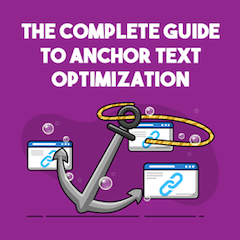
There’s way more to anchor text than turning words into clickable links.
You need to know when to use a certain anchor type, the perfect anchor text ratios for different kinds of content, when it’s “okay” to use exact-match anchors, and when it’s not, plus much, much more.
If you’re looking to optimize your anchors with the very best anchor text strategies (that are working right now), then you need to keep reading this guide.
In this complete anchor text resource, I’m including a comprehensive breakdown of what anchor text is, its role in your site’s SEO performance, as well as dozens of tips and techniques to ensure you get the most out of your site’s anchor text profile.
Let’s jump right in.
Bonus: Download a free cheat sheet that will show you how to implement these anchor text tips. Includes step-by-step frameworks for two bonus strategies not included in this post.
What is Anchor Text? (A Simple Definition)
Anchor text is the clickable text in an HTML hyperlink that links two web pages together.
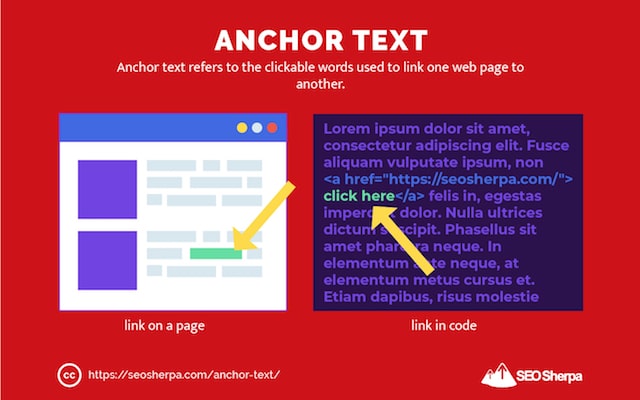
Typically, anchor text appears as a blue (sometimes underlined) string of text. The contrasting color helps users differentiate the anchor from other, non-clickable text on a web page.
In the HTML, your anchor text is coded like so:
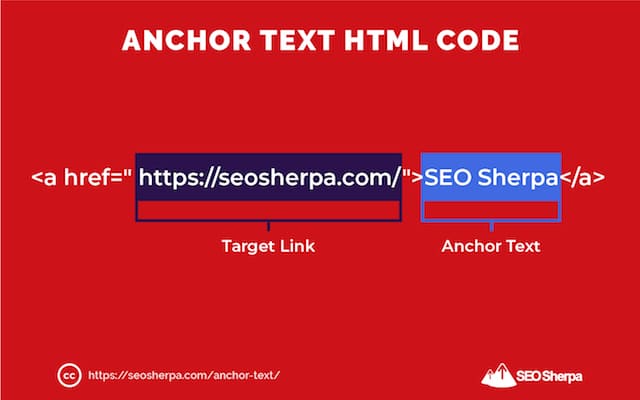
Since Google’s inception, anchor text has been a foundational aspect of Google’s (and other search engines’) algorithms.
Search engines use the anchor text on one page (plus the content surrounding it) to determine the context of the page being linked to.
In fact, Google states in their patent that anchor text pointing to a page can be more useful than even the content on the target page when determining what to rank the page for.
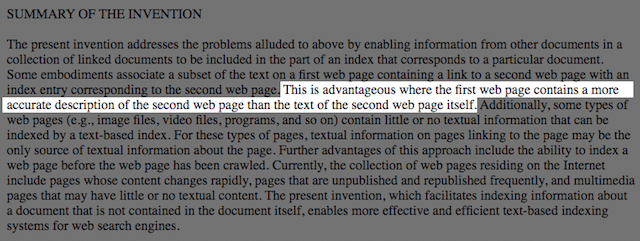
As these clues signal, anchor text is an essential search engine ranking signal.
And if used correctly, can significantly improve your ranking chances.
The Role of Anchor Text in SEO (And How You Can Use It to Your Advantage)
As the name suggests, anchor text literally anchors two web pages together, allowing site visitors to click from one URL to another.
But, anchor text can do more than link two pages. Anchor text can also anchor other media formats like images, documents, programs, or files.
Take this post, for example, we’ve used a clickable anchor text link to serve a lightbox pop-up:

The uses cases are several.
But, by far, the MOST important application of anchor text for SEO is internal and external links between pages.
Allow me to explain.
By selecting certain words to hyperlink, you send signals to both search engines and search users alike.
In other words:
Site visitors use anchor text to preview what the link destination may be.
For instance, visitors to the Siege Media blog know that by clicking on the text “Moz’s keyword difficulty tool,” they’ll get directed to, guess what? The Moz Keyword Difficulty tool.

The anchor text sets a clear expectation for readers. Using specific anchor words that describe the content being linked to provides a positive experience for users.
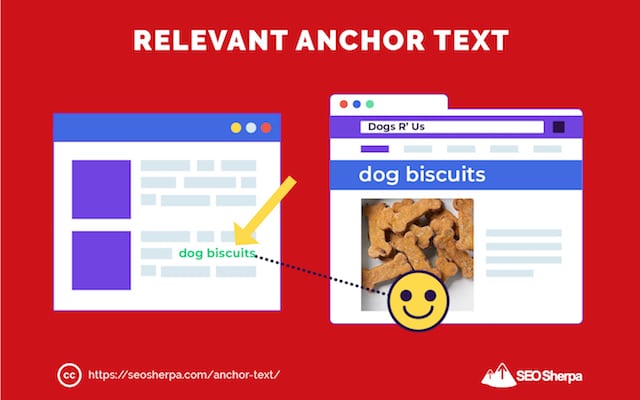
On the other hand:
If readers were to click on anchor text that said “dog biscuits” and landed on a page about dog collars, they’d feel misled and frustrated, leading to a poor user experience and increased bounce rate.
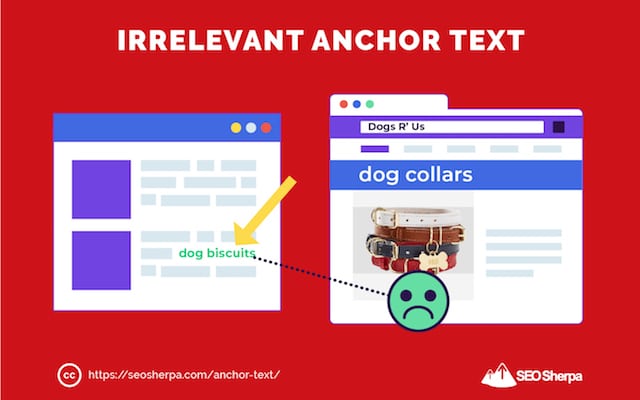
Search engines also view hyperlink text in a particular way.
In short:
Google’s algorithm uses anchor text to better understand the linked-to page’s topic.
When several links to a page all describe it in a similar way, search bots gain confidence about the page’s subject.
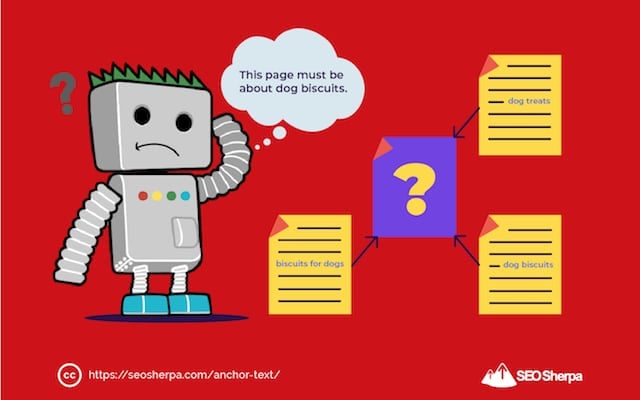
Which increases that page’s ranking for keywords relating to that topic.
As such, many websites have overly optimized their anchor text with the goal of winning a ranking advantage.
Enter the Penguin update.
Google Penguin Algorithm Update and Anchor Text Optimization
In the early version of Google’s search algorithm, anchor text was easy to manipulate.
By simply spamming exact match anchor links (anchors using the exact target keyword) at a page, SEO’s ranked their URL in the upper positions of Google, often at position one.
This practice was known as “Google Bombing” and resulted in a tonne of non-relevant or low-quality pages soaring high within the SERPs.
Here’s one hilarious example where links were pointed to Tony Blair’s biography page using “liar” as the anchor:
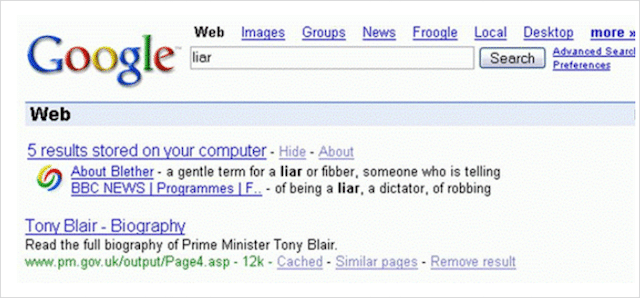
Thankfully, this tactic came to a halt in 2012 with Penguin 1.0.
The first Google Penguin algorithm update focussed on webspam in search results.
The result being, websites found to purposely manipulate search results with anchor text spam (among other black hat SEO strategies) were penalized.
A HUGE number of websites lost their rankings and traffic overnight:

Subsequent Penguin updates have continued the war on manipulative anchor text practices.
Consequently, effective anchor text optimization today is about avoiding spammy anchor text profiles, not creating them.
But before we touch on the different types of anchor text and their purposes, let’s have a look at the two primary places where anchor text will appear.
Internal and External Anchor Links: How to Leverage Them to Your Benefit
How you optimize your anchor text will be decided by whether the link is internal or external.
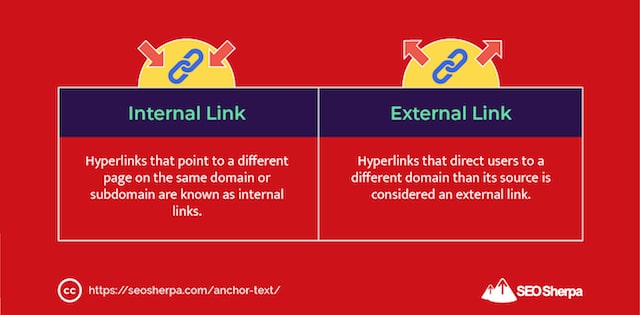
Let’s go through both in detail.
Internal Anchor Text Optimization
Internal links provide several benefits to your site.
They pass link value from one page to another, improve site usability and navigation, and help search engines find, index, and understand your site’s content more effectively.
When optimizing your internal link anchor text, you want to avoid stuffing your anchors with exact-match keywords (more on this later).
Like all anchor texts, the words you choose should describe the content you are linking to and naturally fit within the context of the page.
Whenever you create new content, I recommend linking internally to three or four other pages or posts on your website.
But don’t stop there.
You can also find more internal link opportunities by doing a site colon search on Google.
If I wanted to find link opportunities to this post about featured snippets, I’d type “site:seosherpa.com featured snippets” into Google to find other pages on my site mentioning that term.
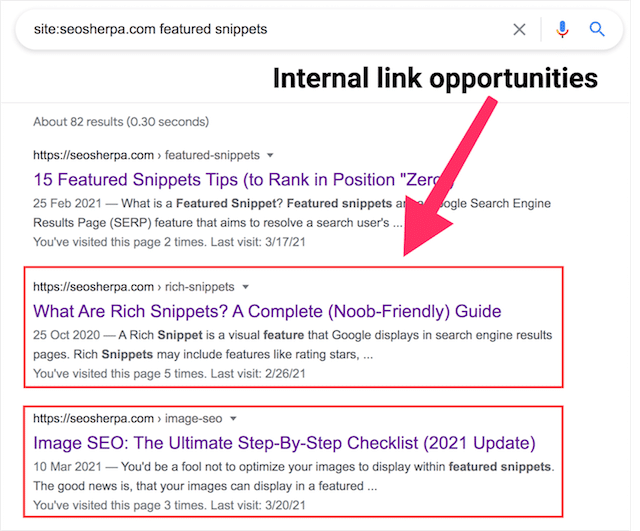
Then all I need to do is login to my CMS and insert a link from that page to my post about featured snippets.
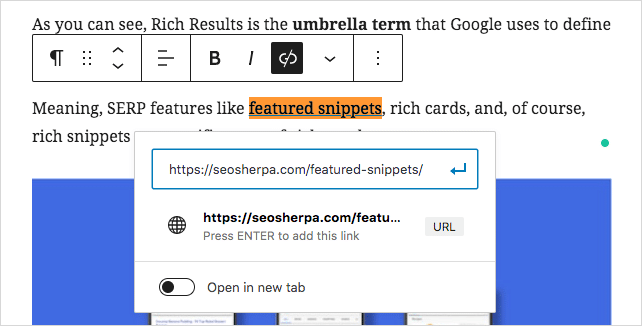
Which is exactly what I did using “featured snippets” as the anchor.
External Anchor Text Optimization
On the flip side, external anchor links are more difficult to control.
Why?
Because the majority of links to your site from third-party websites will be decided by the website owner, not you.
But that doesn’t mean you cannot influence the anchor words used.
Firstly, you can ensure you name your content appropriately. Take this post for example:

I’ve given the post a catchy page title and headline that includes my target keyword “SEO experiments.”
And because the page title and headline are descriptive and compelling, MANY website owners have used them as the anchor when linking to my page.

The simple lesson here is, use the keywords you want to rank for in your header and title tag. Not only will it improve your on-page SEO, but it will also help your off-page SEO since you’ll pick up more links containing partial match anchor terms.
Secondly, you can influence your external anchor links, via any self-managed link building you do.
For instance, when I wrote this guest post for Search Engine Watch, I included links back to the SEO Sherpa site.
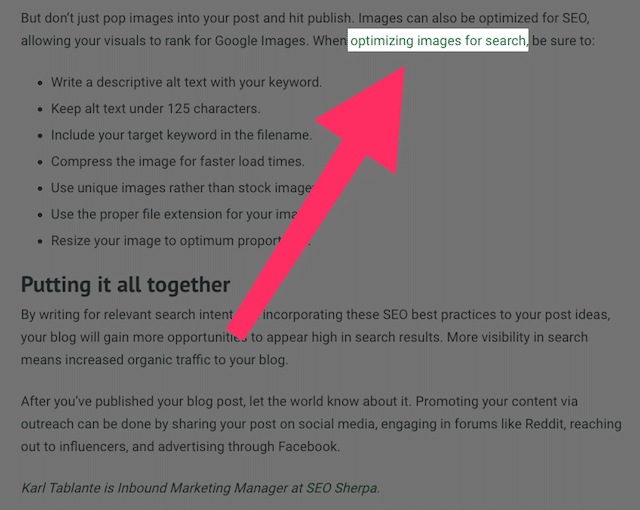
I was careful to use anchors that taught Google what the linked-to page was about and what to rank it for.
(Subsequently that post ranks #3 for “optimize images for search”)
Now you have a high-level overview of anchor links, and you can optimize your internal and external anchors; let’s discuss ten anchor text types:
(1). Branded Anchors
A branded anchor makes use of your brand’s name (or some variation of it) as the anchor text.
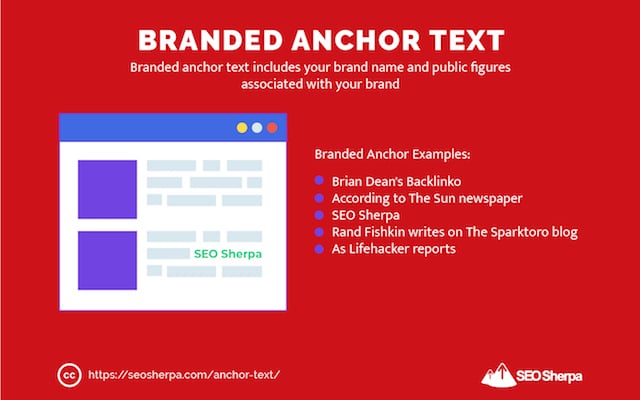
If your link profile is well-rounded, your brand name should be amongst your most used, if not THE most used anchor text pointing to your website.
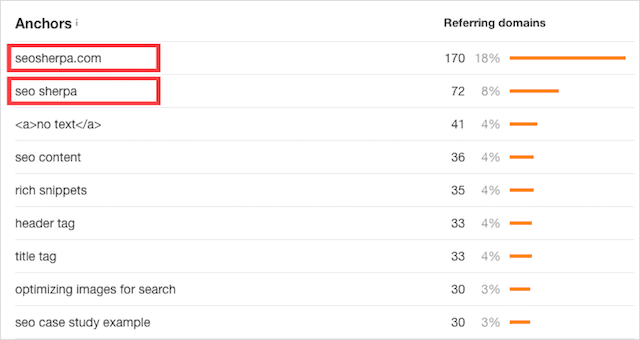
If not, then your anchor text is probably “over-optimized” – more on that soon.
When you build a brand, website owners will naturally link using your brand name when citing your business.
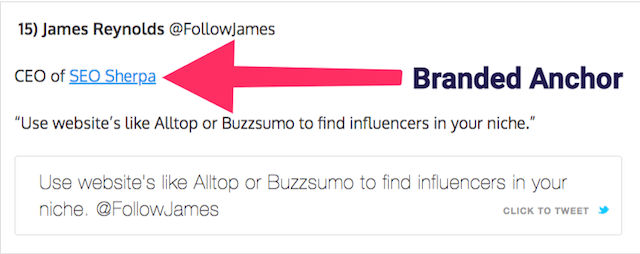
Take Ahrefs, for example:

Over 50% of websites linking to them use the Ahrefs brand name within the anchor.
Or how about Buffer?

Forty one percent of their referring domains use branded anchors.
You get the point:
Branded anchors should be the largest portion of your anchor text profile.
And, here’s the reason:
Google expects branded anchors to be the most frequently used anchor text linking to your site.
And that’s because if you are a known authority in your niche, your brand name is how most websites will refer to you.
A high percentage of branded anchor text (20% or more) is the goal.
And, for your homepage, it should be even higher.
Almost all:
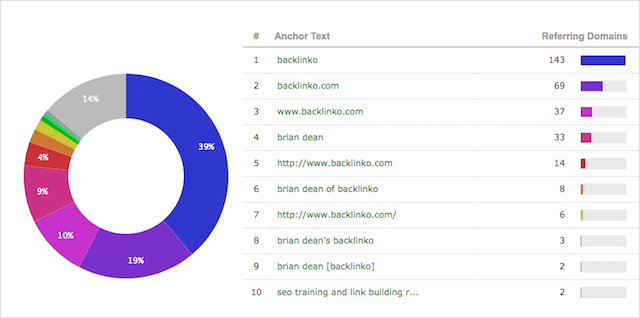
But – and this is a big but – if you use an exact match domain name (EMD), then you should lean on the side of caution and dial down percentages.
As you’ll learn later, too many keyword-rich links pointing to your site could lead to a penalty.
To add more variety to your branded anchors, aim to acquire links containing your personal name and partial match variations.
Here are some branded anchor examples:
- Brian Dean’s Backlinko
- According to The Sun newspaper
- SEO Sherpa
- Rand Fishkin writes on The Sparktoro blog
- As Lifehacker reports
(2). Exact-Match Anchors
As I already shared:
Exact-match anchor text uses the specific keyword you are targeting as the anchor link.
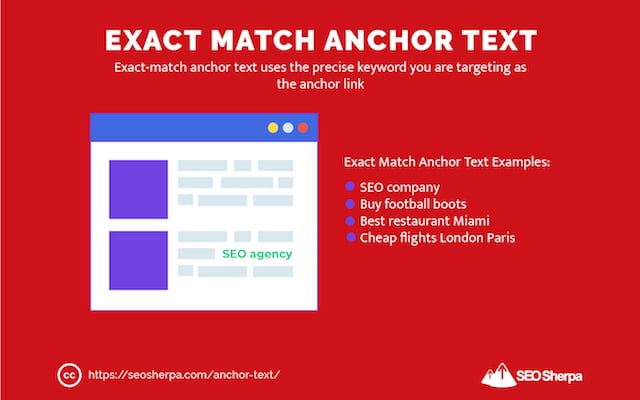
For example:
If the page you’re linking to is targeting the keyword “buy wedding dresses,” the exact match anchor text would be “buy wedding dresses” precisely.
Here are some other examples of exact-match anchor text:
- SEO company
- Buy football boots
- Best restaurant Miami
- Cheap flights London Paris
While it can be useful to win some links for the exact keyword you are targeting…
Be careful with having too many exact-match anchors as it’s unnatural, and could lead to a Google penalty.
Side note – later in this post, I’ll share the percentage you should be aiming for across your entire website, as well as specific page types.
The other downside of exact match anchor text is that it kills click-through rate.
Some keywords in their typed-out form, don’t read naturally. So when forced into content, they appear spammy (which they are).

Unnatural exact match anchors are a huge negative if you’re looking to win referral traffic.
Always keep in mind, the goal with anchor links is to help search engines AND humans know what they’ll land on by clicking the link.
To do that, use more descriptive links.
Which brings us to our next anchor text type:
(3). Partial-Match Anchors
Partial-match anchors use text that includes a variation of the target keyword along with generic terms and stop-words.
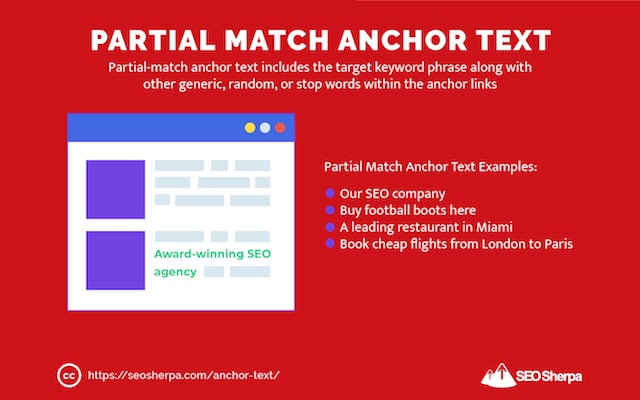
If the linked page is about link building, then a partial-match anchor text could be “link building strategies” or “how to do link building effectively.”
Here are some other partial-match anchor text examples:
- A leading restaurant in Miami
- Buy cheap flights from London to Paris
- Our SEO company
What’s neat about partial match anchor text is that it communicates to Google about the linked-to page’s topic without unnatural links.
Infact, I recommend when doing keyword focussed link building, you use partial match anchor text as frequently as possible – especially when linking to content pages.
This will allow you to write your content as naturally as possible – whether you’re linking from content on third-party sites or page’s within your own website.
Why?
Simply, you won’t have to crowbar the keyword into your content where it doesn’t fit.
Take this post which covers the topic of how to find email addresses for outreach. The main target keyword is “find email address” yet none of the anchors pointing to the page use an exact match of the keyword as the anchor text.
Instead, the links include numerous partial match variations that contain the term “find email address.”
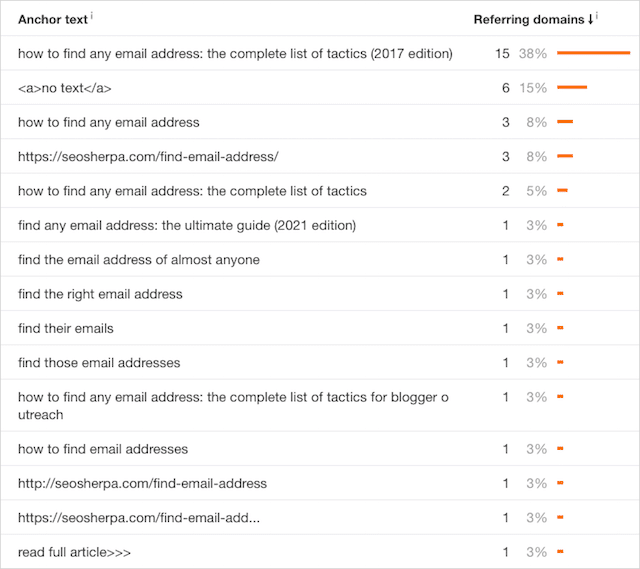
And yet, still, the page ranks a very respectable #6 for this competitive keyword:
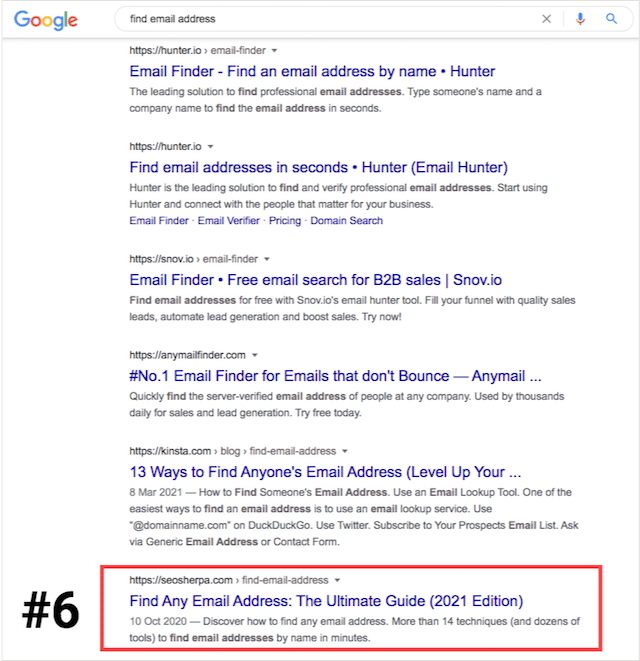
A natural link profile will include many partial match anchor links, which means when building links yourself – partial match anchor text should be the mainstay of your anchor text strategy.
(4). Related Anchors
Like partial-match anchors, related anchor text uses variations of your keyword phrase.
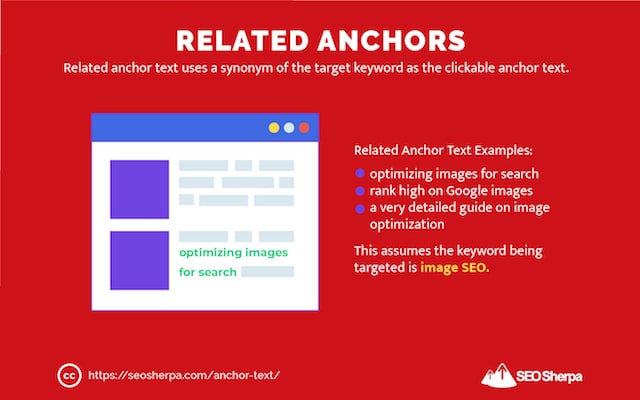
But, unlike partial match anchors, related anchors never include the keyword itself.
So what do they use instead?
Synonyms!
Let’s take this post on image SEO. The main target keyword is “image seo” but, amongst the most used anchors are:
- optimizing images for search
- rank high on Google images
- very detailed guide on image optimization
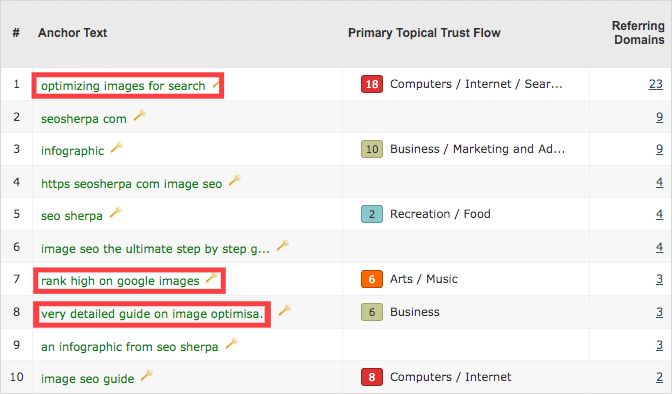
None of which include the term “image seo” itself.
Related anchor texts are useful in building a more diverse link profile, and helping you avoid over-optimization.
There’s no real science to the use of related anchor text…
Just ensure you use a good mix of LSI keywords, plus synonyms and you’re good to go.
(5). Generic Anchors
A generic anchor refers to anchor text that uses common call-to-actions (CTAs) rather than a specific keyword.
Aside from adding more variety to your link profile…
Because generic anchors typically use action verbs, they are a powerful way to encourage more readers to click on your page.
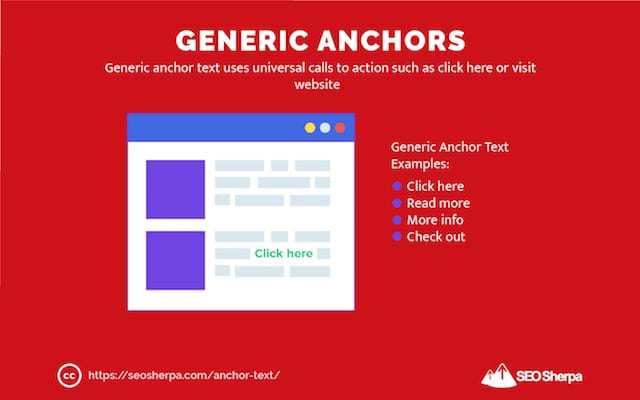
Frequently used generic anchors include:
- Click here
- Read more
- More info
- Buy now
- Sign up
- Check out
- Discover more
- Visit website
A high number of generic anchors is common for an established website.
Just as we see below for HelpScout:

For your link building efforts to be effective, you want a good amount of generic anchor text in your link profile.
I’ll share how much later.
(6). Random Anchors
Like generic anchors, random anchor texts use phrases that do not include any particular type of keyword.
What separates random anchors from generic anchor texts is that random anchors don’t use actionable language.
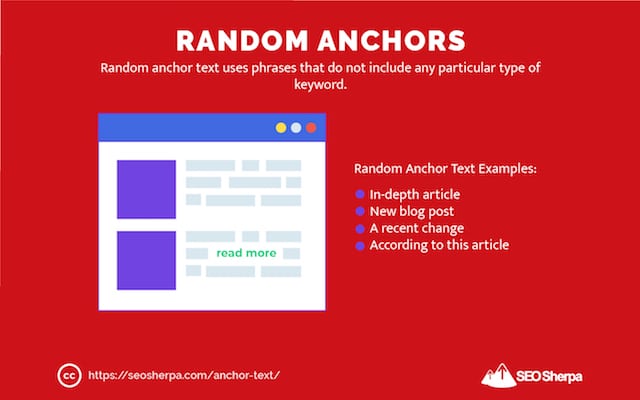
It’s tough to select random anchors’ examples because they are just that, spontaneous and subjective to the page using anchor text.
But still, here are some examples of what random anchors could include:
- In-depth article
- New blog post
- A recent change
- According to this article
Since there is little a search engine can determine from a random anchor, you might be asking, what impact does generic or random anchor text have on ranking performance?
The answer is, not much, if anything.
According to a study by Ahrefs, there is no significant correlation between random anchor text usage and high keyword rankings:
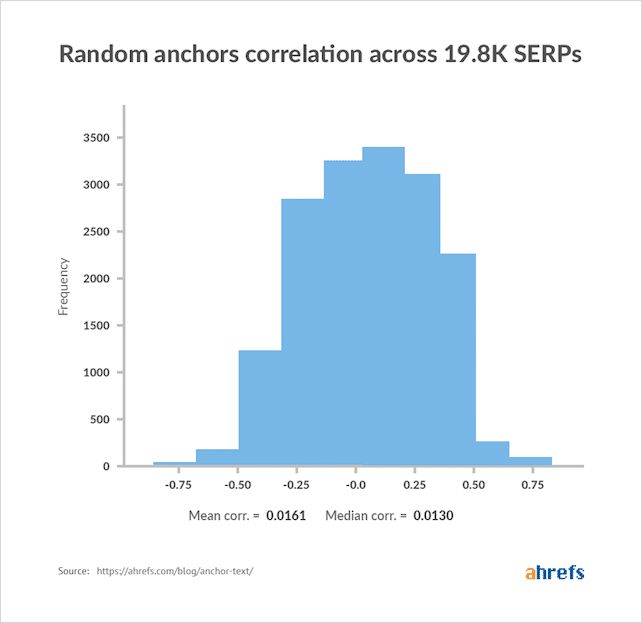
Does that mean you shouldn’t use them?
Not at all.
Using only keyword or brand focussed anchors is unnatural. Plus, there is information Google can obtain from the text surrounding the anchor.
For instance, it’s clear to search bots the content being linked to below is about the basics of SEO even though the mere anchor says “here.”

And this isn’t just hear say, we know from Google’s patents this is fact:
Here’s an excerpt:
Data surrounding the link, data to the left of the link or to the right of the link, or anchor text associated with the link may be used to determine the context associated with the link.
United States Patent – 15th March, 2004
Put another way, if the actual anchor text happens to be random or unrelated to the linked-to page, Google will look at the text surrounding the link to help understand what the page is about.
So the lesson here is, incorporate generic and random anchor texts, but always be sure to place the anchor within the relevant surrounding text.
(7). Naked Anchors
When the raw URL is used as the anchor rather than a word or phrase, it’s known as a naked anchor.
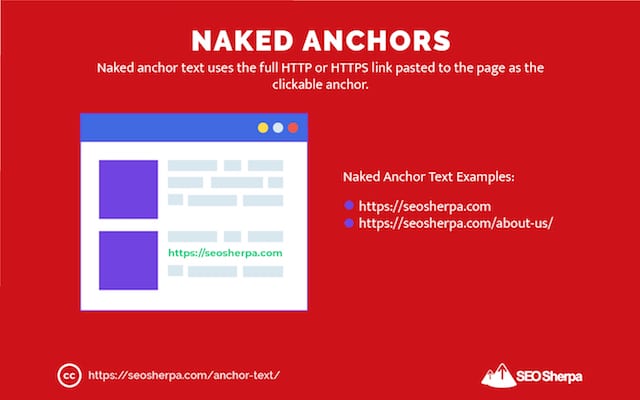
Using the SEO Sherpa homepage as an example:
The clickable https://seosherpa.com is naked anchor text.
Naked anchors are typically found at the bottom of press releases or within author bios on blog posts. Bloggers will also use them to cite contributors in expert roundups:
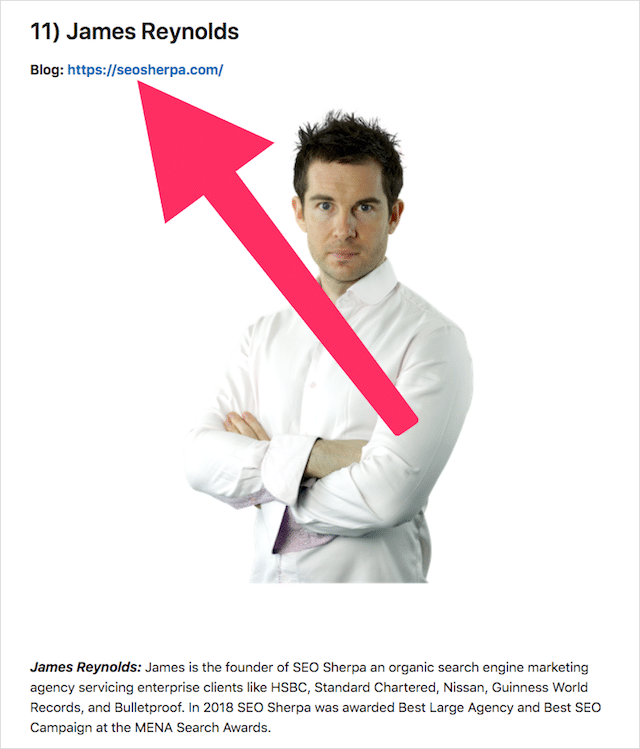
Very little contextual information is included within naked anchor text unless your domain name includes a keyword (like SEO Sherpa does).
With that being the case, the use of naked anchors is entirely safe.
As compared with exact match anchors, there is no deceptive practice being used to manipulate search rankings with specific keyword use.
And, just like generic and random anchors, when the text near a naked anchor contains contextual information, it can have a ranking benefit.
(8). Brand & Keyword Anchors
This type of anchor text makes use of brand names and partial-match keywords.
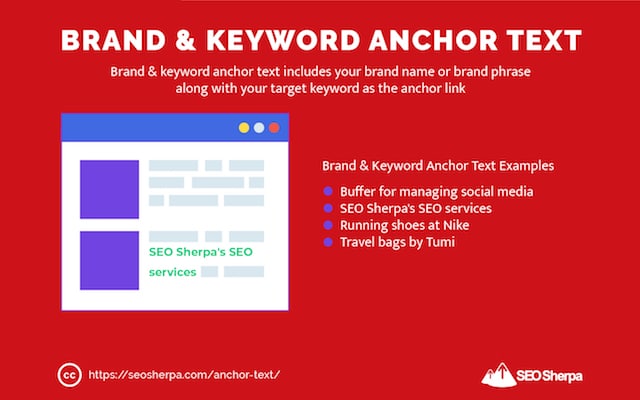
Typically, brand and keyword anchors are used when a site tries to optimize for a keyword while strengthening co-occurrences.
What are co-occurrences I hear you ask?
Co-occurrence is a concept that refers to the common presence, frequency of occurrence, and close proximity of similar keywords present across several websites. Co-occurrence may include keywords that are similar to each other and based on the same topic but are not exactly the same.
In simple terms:
By including your brand name alongside the keyword you want to rank for, you associate the two together, helping Google connect your brand to the core products and services it offers.
An example of a brand and keyword anchor that makes use of co-occurrences would be “running shoes at Nike” or “Ahrefs for keyword research”.
Here are some more brand + keyword anchor examples:
- Buffer for managing social media
- SEO Sherpa’s SEO services
- Travel bags by Tumi
The goal here is to correlate your brand name (or brand phrases) to your target keyword phrases.
Make sense?
Cool, let’s move on to our ninth anchor type.
(9). Long-Tail Anchors
Long-tail anchors are another variation of the partial-match anchor, except they contain more words, usually four or more.
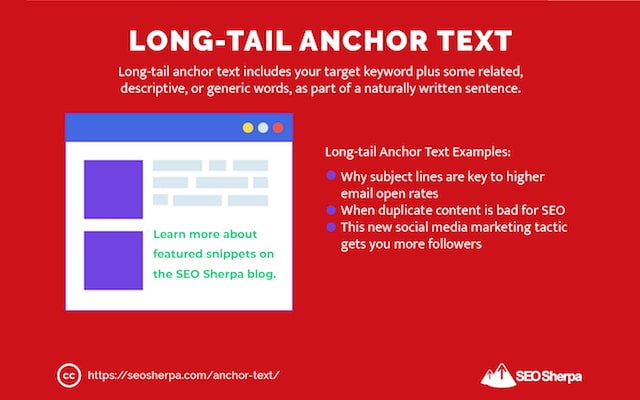
On top of including your keyword into the anchor text, long-tail anchors also include descriptive, generic, or branded terms.
An example of long-tail anchor text could be “why e-commerce stores should invest in local SEO” with the link pointing back to a page about local SEO strategies.
More Long-Tail Anchor Text Examples:
- Learn more about featured snippets on the SEO Sherpa blog
- Why subject lines are key to higher email open rates
- This new social media marketing tactic gets you more followers
Long-tail anchors occur naturally when other websites link to you.
Often writers will include an entire subheading or headline for a link.
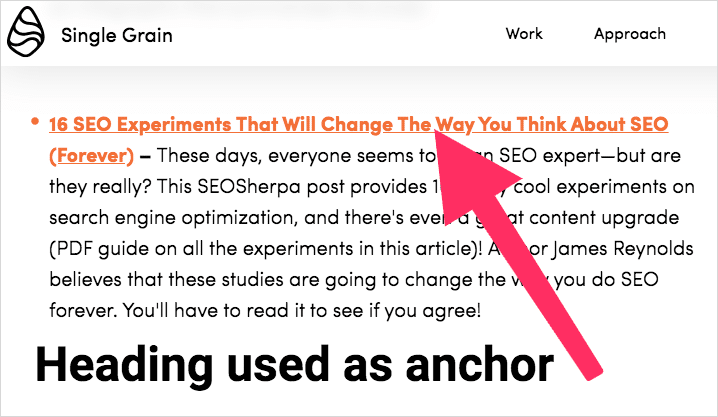
Other times, writers will link from a complete sentence.
Because long-tail anchors naturally occur, they needn’t be a primary focus of your link-building strategy.
Still, they can be useful for diversifying your link profile and helping you rank higher for long-tail keyword terms.
(10). Image Anchors
Text-based anchors are not the only anchor type.
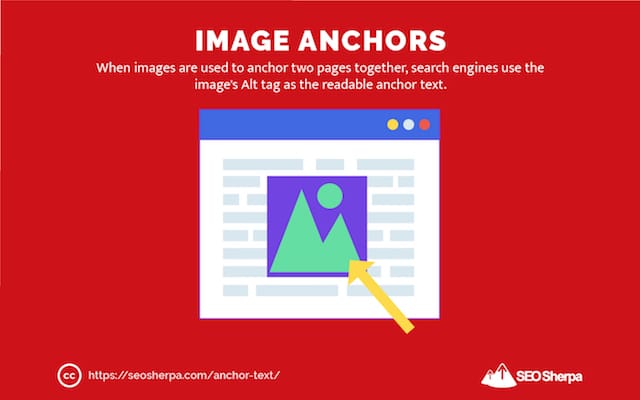
Images can also be used to anchor two pages together.
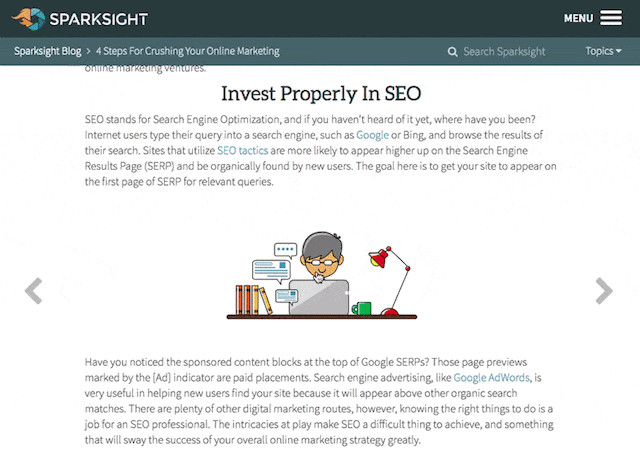
Since there is no clickable text in an image anchor, Google uses the image’s Alt text to understand the context of the linked to page.
For that reason, it’s important to write descriptive, keyword-focused Alt tags for your images.
If you are new to alt-text writing, you can refer to our image SEO guide for a step-by-step tutorial on Alt tags and the entire optimization process.
Like the other anchor types above, image anchors play an important role in a healthy link profile.

In fact, a well-round link profile might expect 5-25% of all links to be from images.
Now that you know this history of anchor text and how to diversify your link profile using the ten anchor text types…
Let’s look at the key strategies you can implement today to optimize your anchor text for SEO.
Eight Strategies to Optimize Your Anchor Text (And Rank Higher in Search)
Knowing about anchor text is great.
But if you want to leverage anchor text to improve user experience and rank higher in search, then you need some proven anchor strategies in your tool kit.
Next, I’m going to share eight anchor text tips and tactics you can use on your site today to gain a ranking advantage.
Let’s begin:
1. How to Get Your Anchor Text On-Point by Perfecting Your Exact-Match Percentage
Too many exact-match anchor links in modern-day SEO are dangerous and can lead to search ranking catastrophe.
But don’t get me wrong.
I’m not suggesting you forgo exact-match anchors entirely. The exact opposite is true.
As I alluded to, exact-match anchor texts help readers and search engines identify precisely what the linked-to page is about. And, in the case of search engines, the specific keyword that page should rank for.
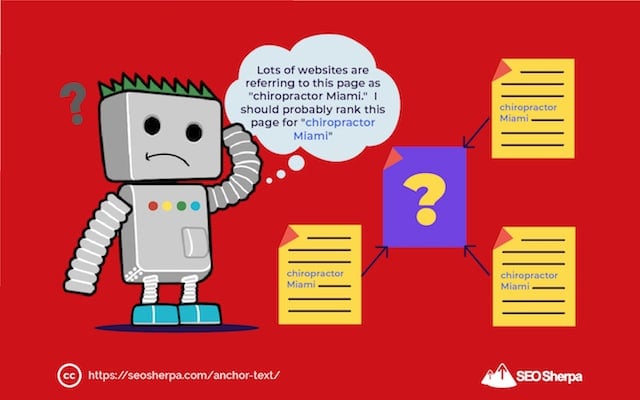
But because exact-match anchors worked like gangbusters, SEOs spammed their sites with them until Google released the Penguin update, and the manipulative practice got penalized.
Which bodes the question:
How should you use this now “taboo” anchor text type as part of your link profile today?
Well, according to Google, matching the exact text of the page, you’re referring to is a best practice. At least to a certain extent.

Google prefers exact-match anchors or partial-match anchors over generic and random anchors. They provide a better user experience by presenting a more explicit descriptor of the page being linked to.
Still, just because Google recommends using exact-match anchor text doesn’t mean you should be stuffing exact match anchors to every page on your site or sites you post on. Instead, use exact-match anchors sparingly.
Just how sparingly, though?
In their analysis of anchor text types and rankings, Ahrefs found a “relatively weak correlation between the percentage of exact-match anchored links and rankings.”
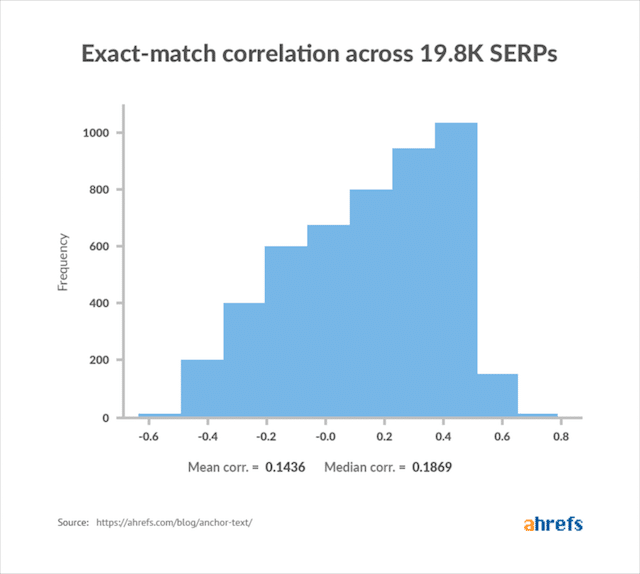
Some folks in the SEO community have gone even further and recommend that you should only use exact-match anchors between ~1% to 5% of the time.
But that’s a sweeping generalization.
If the exact keyword is naturally occurring, percentages far higher than that are reasonable.
Take this post about header tags optimization.
A HUGE forty-seven percent of the domains linking to that post uses the term “header tag” as the anchor:

And yet, still the page ranks in position three for that keyword.
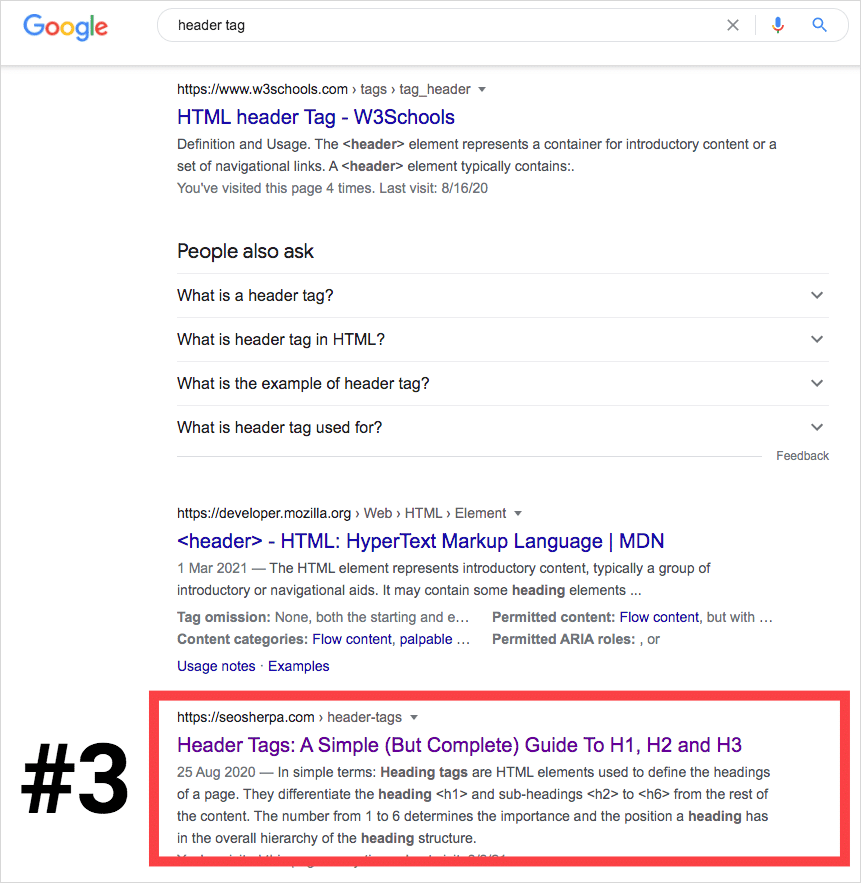
But, let’s now assume your target keyword is “best physiotherapist dubai.”
Do you think that half of the websites that refer to a page on that topic would use “best physiotherapist dubai” as the anchor?
Of course not.
That term would never be used naturally within a sentence.
Since Google no longer relies on keyword frequency when determining a page’s relevancy, the takeaway here is to use exact-match anchor text sparingly.
And, ONLY when doing so will fit naturally within a sentence.
2. Choose the Right Kind of Anchor Text Type for Your Content
How Google and site visitors interpret your links boils down to the kind of anchor text you use. And with the release of the BERT update, Google has improved how it understands and ranks pages tremendously.
Thanks to this natural language processing update, Google’s use of the content around anchor text when matching content to search queries has improved.
With this in mind, use a good mix of anchor text types and avoid relying on exact-match anchor text which can get your website penalized.
But here’s the thing:
It’s not just exact match anchor text you need to be mindful of, there are other anchor types that are bad in certain linking building scenarios.
And, when you use the wrong anchor type in the wrong scenario your SEO performance will be compromised.
So, how do you know which anchor text type to use and when?
Let’s break this down in detail with some examples.
Profile Links
When it comes to profile links, opt for branded or naked anchor text.
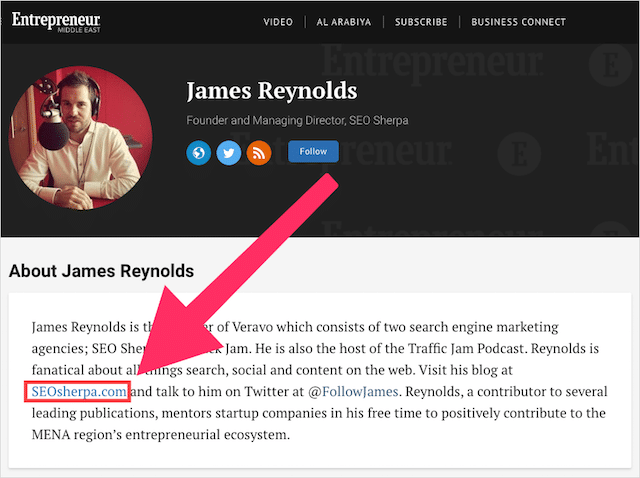
These links are not used for direct ranking benefit but rather to help support your brand’s overall link profile. When you’re guest posting, any links in your bio or profile should be branded or naked.
Directory Links
For online directories or citations, branded, naked, or generic links like “click here” or “visit website” are the most natural anchor texts you can use.
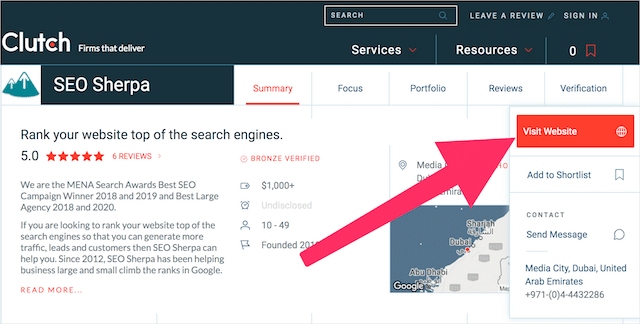
Since you want to encourage readers to your site, a generic anchor with actionable language adds extra motivation for directory users to drop by your website and explore your products or services.
Contextual Links
Contextual links, on the other hand, can be organic or built/earned.
Because you have no real control over organic links, especially if they come from the press, you’ll likely see branded, naked, and longtail anchors.
From time to time, you may expect to acquire some generic anchors like “read more.”
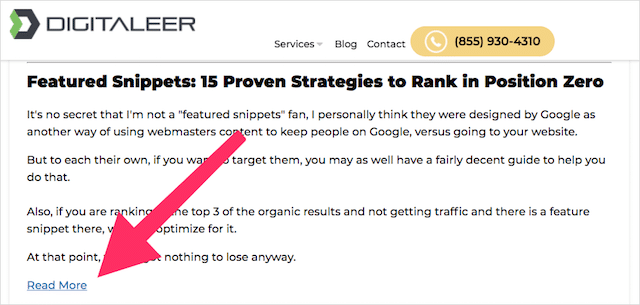
Earned contextual links on the other hand give you the opportunity to use exact-match or partial-match anchors.
Read any guest post or blog online and you’ll rarely come across any naked or branded anchors within the page’s content.
That’s because naked and branded anchors appear self-promotional. Google dislikes self-promotional links and limits their effectiveness in its algorithm.
Furthermore, when links appear unnatural or overly promotional, your site may experience a manual penalty from Google.
Which leads me to my next point on built contextual links.
When guest posting, link back to your own site sparingly and only when it adds value for the reader.
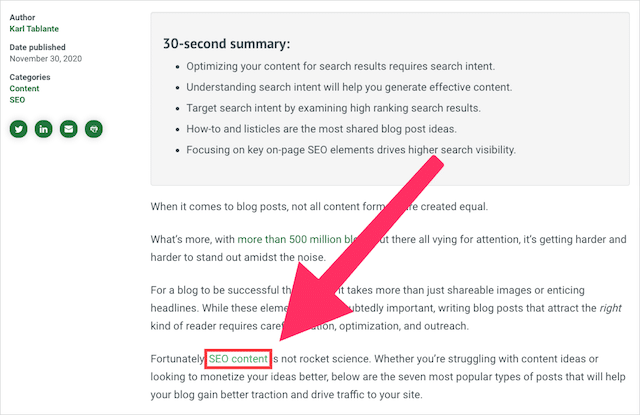
If your guest posts don’t provide utility for the reader and are littered with promotional links, chances are, you’re hurting your brand more than you’re helping anyway.
And finally, concerning anchors for contextual links…
Default to partial match anchor text.
You can use exact-match anchor text occasionally and only where it fits naturally within the content.
3. Avoid Earning Links from Toxic or Spammy Sites (And How to Identify Them)
When it comes to backlinks, any link that violates Google’s Webmaster Guidelines is considered manipulative.
Links that are deemed a link scheme by Google should be avoided. The use of manipulative links can lead to diminished rankings or, worse, manual action and removal from the search results entirely.
Google is explicit about unnatural anchor text use:
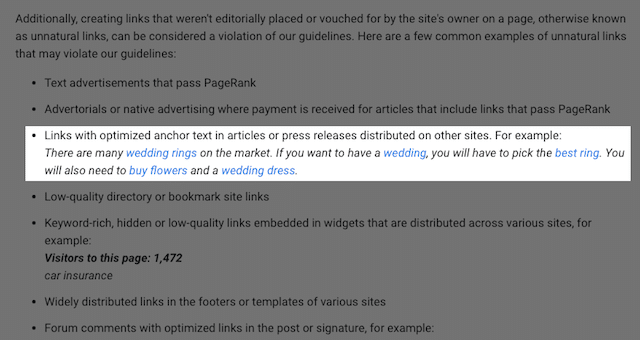
Unnatural anchor text “violate Google guidelines” and offenders will be penalized.
If you’re building links “intended to manipulate PageRank or your ranking in Google” whether that be unnatural anchors, or otherwise, you are living dangerously.
Any form of manipulative link building can lead to a manual or algorithmic penalty resulting in a significant decline in organic rankings, visibility, traffic, leads, AND sales.
And if that wasn’t enough, recovering from a Google penalty is arduous and tiresome. Infact, even after addressing manipulative link practices, most websites never get back to their pre-penalty traffic levels.
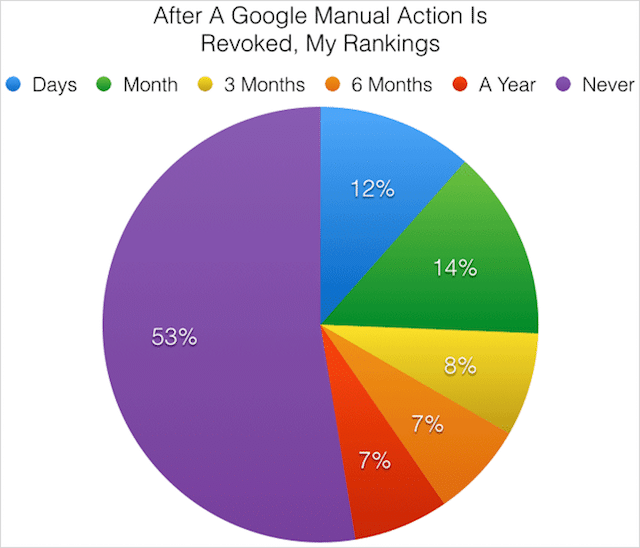
Given that your recovery chances are less than fifty percent, when evaluating any potential link opportunity it’s definitely better to err on the side of caution.
So how do you remain cautious, while differentiating between quality link opportunities and toxic ones?
Well here’s a quick checklist of backlinks to avoid:
- Links come from sites built for the sole purpose of backlinks
- Links that come from sites that are not topically relevant
- Links come from sites not indexed by Google
- Links placed unnaturally in blog comments
- Links that are hidden in the website’s footer
- Content that is marked sponsored but uses followed links
- Links used from Private Blog Networks (PBNs)
If your site receives any of these links, be sure to reach out to the webmaster and ask for it to be removed. If the link has some traffic potential then an alternative would be to keep the link with a no-follow (rel=”nofollow”), sponsored, or UGC attribute added to the link.
Any links you cannot change, can be disavowed.
4. Focus on Relevancy When Choosing Anchor Words
Google’s search algorithm has evolved a lot over the years, yet still, one ranking factor remains as vital now, as it did in the early days.
I’m talking about link relevance.
If you are new to the concept of link relevance, here’s a quick explanation:
Links to websites are viewed as “votes.” The more votes a web page gets from authoritative websites, the better its chances of ranking high within results pages.
But Google doesn’t just look at the number and strength of the links (e.g., link popularity) when determining a page’s ranking.
It also looks at how topically relevant those links are to the context of the linked-to page.
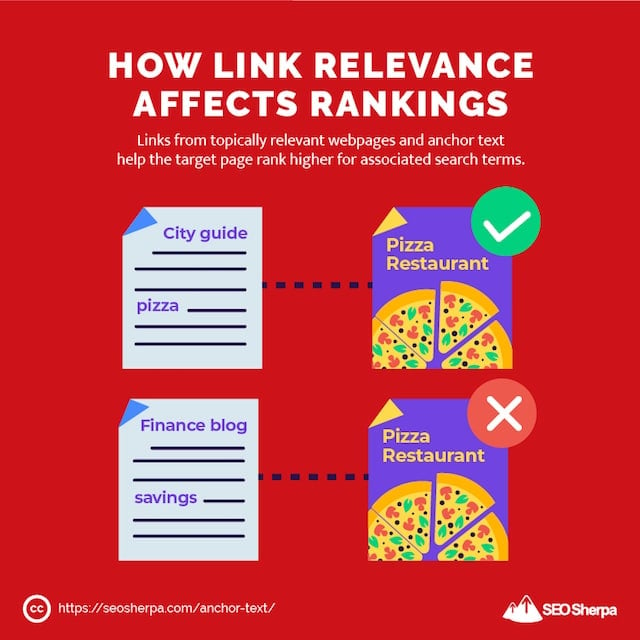
For example, suppose you operate a pizza restaurant. A link from a food or travel blog tells Google that your website is a trusted authority in its field.
On the contrary, getting a link from a financial site or an automotive blog won’t have so much impact whatever the link’s authority. That’s because a financial site or automotive blog lacks topical relevance to a pizza restaurant.
Context matters too.
As Siege Media points out, a blog post on teaching kids about money would be less relevant on a financial site than it would on a mommy blog.
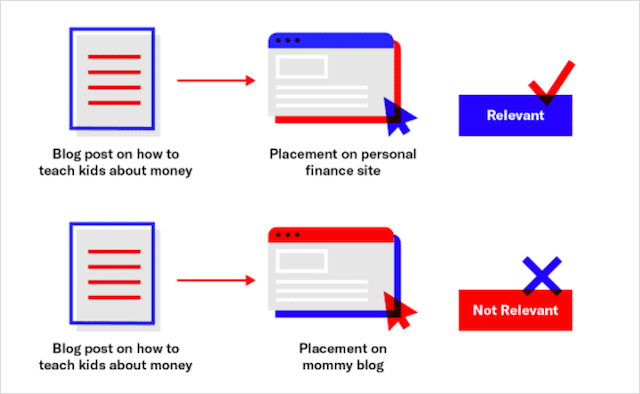
You probably know where this is going in terms of anchor text.
Even if you don’t use exact-match keywords in your anchor text, your anchor text should still be descriptive enough, so users understand what the target page is about.
When selecting words for your anchor text make the anchor link indicative of the content being linked to.
For this post and infographic which teaches readers how to write SEO content, here are differing anchors and their degree of relevance:
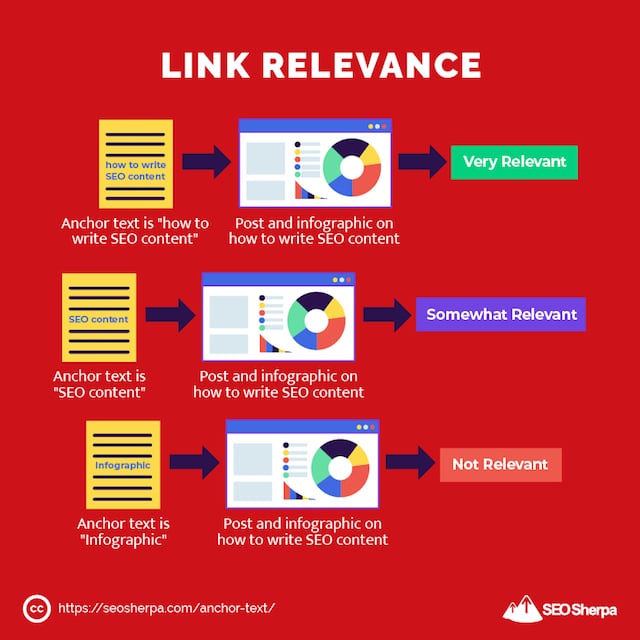
The lesson here is that aside from accessibility, search users and search engines use your anchor text to preview what the linked page is about.
It’s best to avoid hyperlinking off-topic anchor words like “infographic” or “this post” as they provide little information to search engines or users.
5. Diversify Your Link Profile with Safe Anchor Text Percentages (And How to Know When They Are)
Randomness is key to having a healthy link profile.
It’s natural!
What does this imply for your anchor text?
It means, aside from your brand name(s), no anchor text should make up any significant portion of your total link profile.
Take the links pointing to Brian Dean’s Backlinko.com:
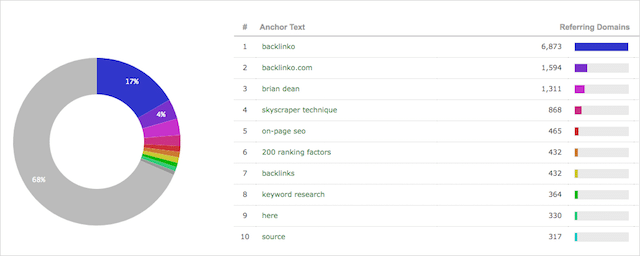
Aside from his brand terms:
- Backlinko
- Backlinko.com
- Brian Dean
- Skyscraper technique
Not one other anchor text makes up greater than 1% of his complete link profile.
As a site-wide average, no more than 1/100th of your total link profile being any single non-brand keyword is a GREAT target to aim for.
You should also be mindful, of the total “other” anchor texts.

Safe and diversified anchor ratios like those above, have between 50% and 70% of their anchors listed as “other.”
This simply means that their top-ten anchors make up no more than 30% to 50% of their total anchor text links – and those top-ten should consist mostly (if not entirely) of brand and generic terms.
Back to you:
Head on over to Majestic.com and check your own anchor text profile using the summary report.
If your anchor ratios look like this, then your anchor texts are safe and diversified:
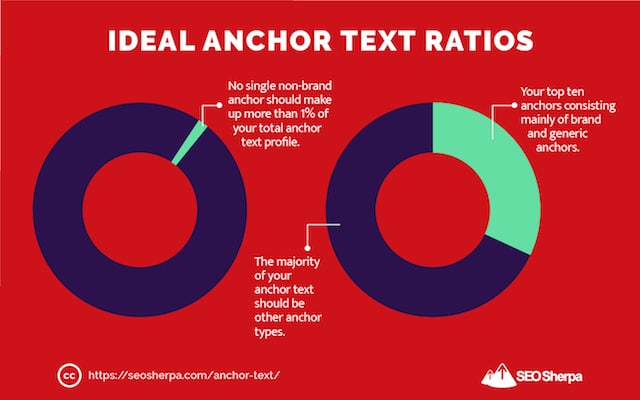
If they don’t, then you probably need more variance in your anchors to stay on Google’s good side.
6. How to “Optimize” the Content Surrounding Your Anchor Text to Leverage the BERT Algorithm
Google has become even more proficient in understanding language in the way that humans do.
Case in point being the BERT update of 2019.
Prior to BERT Google relied heavily on query to document matching.
After BERT, Google returns more relevant answers, even if the query is not contained within the page.
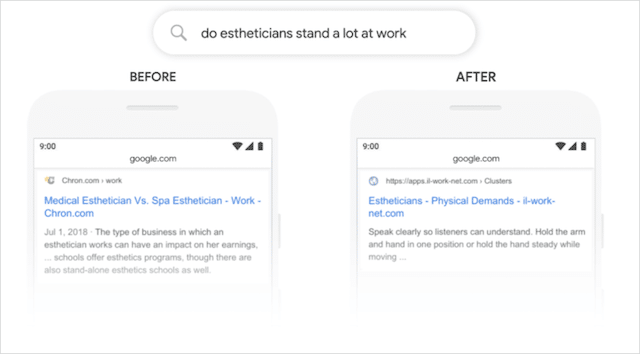
This innovation is referred to as natural language processing and it’s a pretty big deal.
Search Engine Land has described the impact of the BERT update and natural language processing as the “biggest change in search since Google released RankBrain.”
OK, but what does this mean for your anchor texts?
It simply means you can pretty much forget about keyword targeting within your anchor links and you’ll still rank OK.
Whether you include a keyword in the link or not, Google’s going to work out the context of the link based on the natural language surrounding it.
In other words, the passage of text where the link is placed is extremely important.
If you have the ability to affect text surrounding the link pointing to your page, you should “optimize” it.
By optimize, I really mean use natural language containing latent semantic keywords.
To find terms that could be used naturally within the surrounding text, add your main target to lsigraph.com.
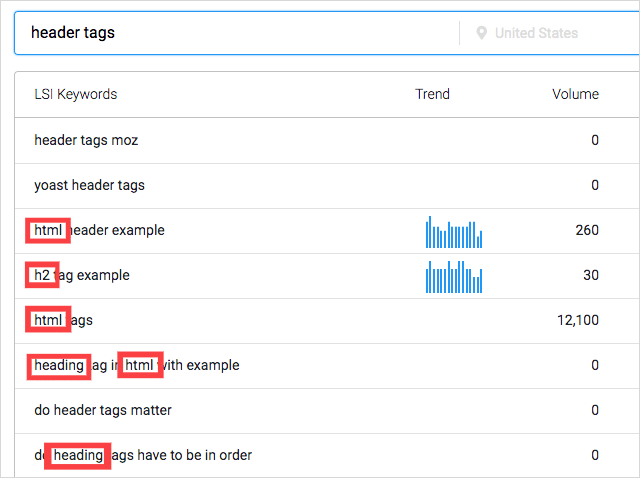
If I were doing this for our post on header tags, I’d look to include LSI keywords like heading, HTML, and H2.
7. Don’t Forget Image Anchors
There’s a persistent myth that YouTube is the second largest search engine in the world.
That title actually belongs to Google Images, having 4x more search volume than YouTube, making it an undeniable search juggernaut.
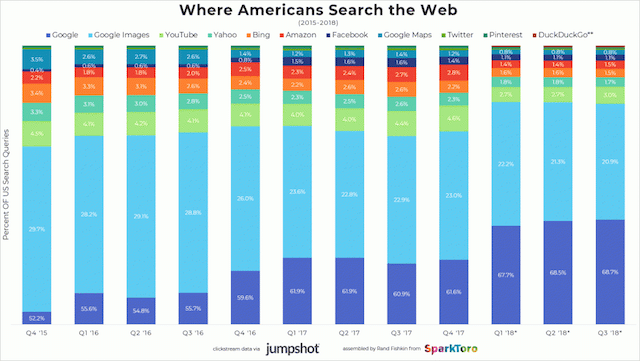
One of the most important facets of image SEO is the ALT text.
This text alternative is used for accessibility purposes when the image fails to render and as a descriptive tool for Google’s bots to better associate the right keywords to your images.
As Google states, adding more context to your images can lead to “higher-quality traffic to your site.”
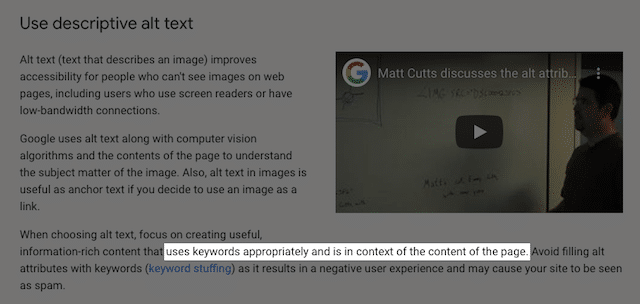
Your images’ ALT text also has a third function.
Since Google can’t “read” images in the typical sense, your image’s Alt tag acts as the anchor text when that image links to another resource or page.
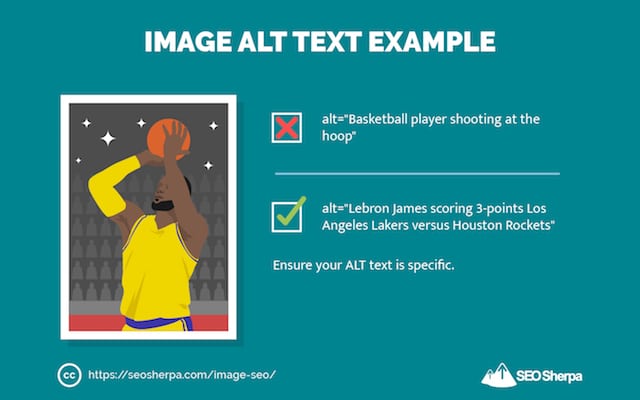
In our Image SEO guide, we provide a 5-step process to writing descriptive and SEO-optimized ALT text.
The five steps are:
- Ask what information would be helpful to someone who cannot view this image?
- Finish this sentence: “This is a(n) image, screenshot, photograph or drawing of __________.”
- Remove any conjunctions or connections (e.g. a/an).
- Include your target keyword in your ALT text towards the beginning of the tag.
- Keep your ALT text less than 125 characters.
Following these five steps will ensure your image Alt text is descriptive and provides more context to search engines (and the visually impaired) concerning the image itself AND the page being linked to.
8. Calculating the Perfect Anchor Text Ratio
By now, you’ve got a firm grasp on anchor text best practices.
But still, you may be left wondering:
What is an ideal percentage for each of the anchor types?
Most SEOs will tell you there is no perfect percentage to anchor texts.
And while that may be true to a point, we can infer the ideal anchor text ratios based on SERPs analysis and various SEO studies.
In Ahrefs analysis of anchor text types and rankings, they discovered that there is little correlation between exact-match anchors and rankings.
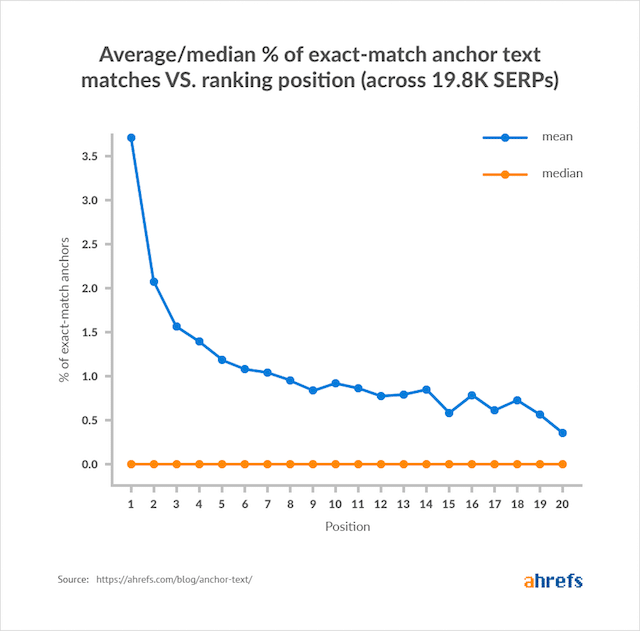
The same can also be said for phrase-match and partial-match anchor text types.
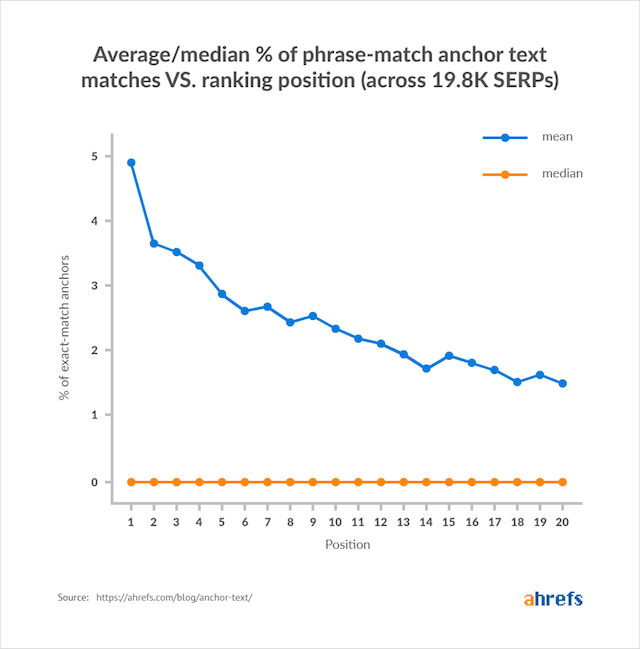
Ahrefs’ study went further to analyze other anchor text types like random and generic anchors.
So for example, if the keyword was “link building” then the random/generic anchors would be something like “click here” or “this article.”
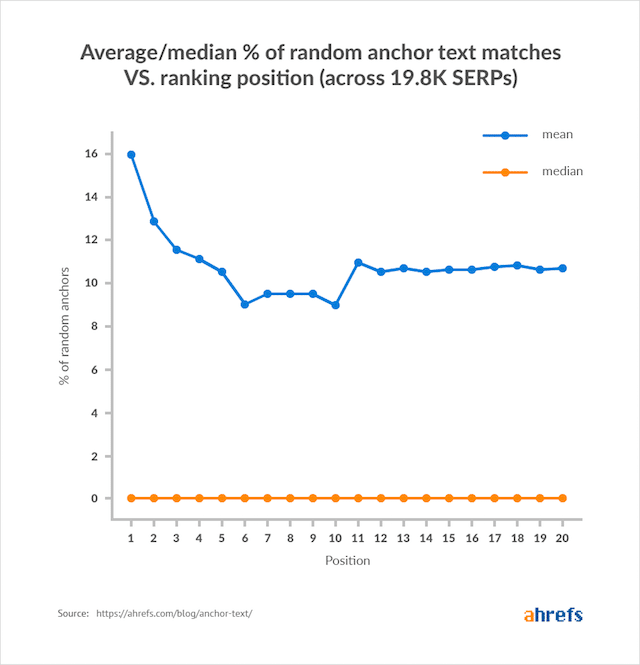
While the graph above may show the average percentage of random and generic anchors pointing to top-ranking pages is higher than exact-match or phrase-match anchors…
The correlation between anchors and rankings was effectively null.
Why is this you may ask?
Despite Google stating they use anchor text to attain context about the page being linked to, the search engine has never been transparent about how much weight certain anchor types are given in their algorithm.
With that in mind, we turn to the SERPs for clues.
Clayton Johnson of The HOTH, analyzed thousands of links for various number one ranking results (number undisclosed) to determine the ideal anchor text ratio. His goal was to determine the model ratio of anchor types for two-page versions; homepages and internal pages.
For simplicity Clayton categorized each link he analyzed in to three categories:
- Exact-match anchors
- Partial-match anchors
- Brand, natural and URL anchors
Here’s what he found:
Homepage Anchor Text Ratios
For your homepage, your anchor text should look like follows:
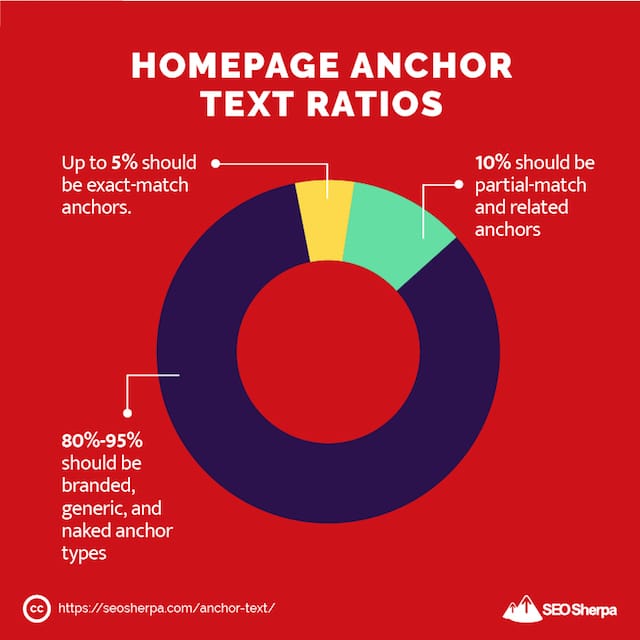
- 80%-95% of all anchor text should be branded, generic, and naked anchor types
- Up to 10% of all anchor text should be partial-match anchors and related anchors
- Up to 5% of all anchor text should be exact-match anchors.
This data makes complete sense. A trusted brand will be referenced frequently, and when it is, the page most commonly linked to will be the homepage.
Internal Page Anchor Text Ratios
For your site’s inner pages such as product, category, and blogs, anchor text ratios should break down as such:
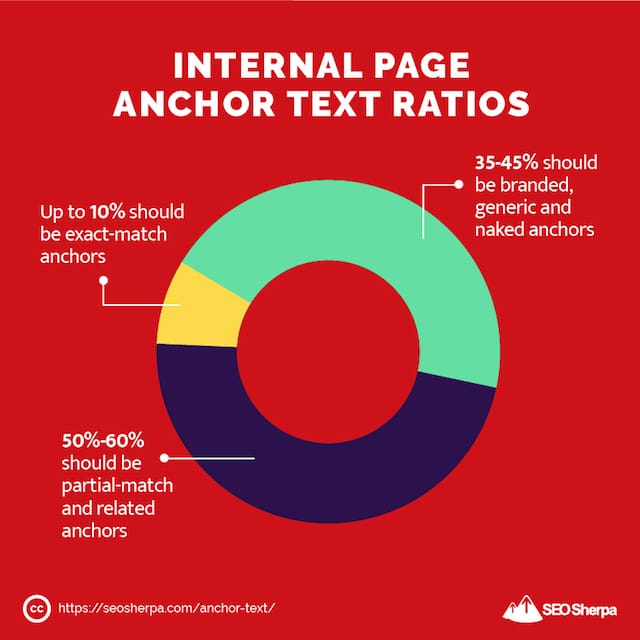
- 50%-60% of all internal page links should be partial-match and related anchors
- 35-45% of all internal page links should be branded, generic, and naked anchors
- Up to 10% of all internal page links should be exact-match anchors.
Because a large part of search targets your site’s internal pages, you want the majority of your anchor text for these pages to heavily target your core keyword and phrases.
And since a natural link profile will include many throw-away anchors, the second-largest anchor text types you want to aim for are generic and naked anchors.
As for exact match anchors?
These should make up no more than 1/10th of links to internal pages.
To ensure you fall well within these anchor text ranges, let me next show you how to audit your site.
Auditing Your Current Anchor Text Ratios
There are several tools you can use to audit your site’s anchor profile. I’ll share two:
Ahrefs
If you’re using Ahrefs, type the page you want to audit into Site Explorer and navigate to Anchors on the left-hand side.
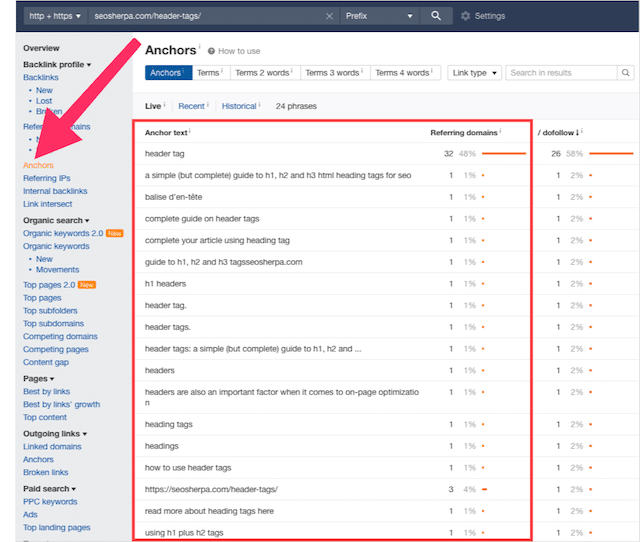
Now have a look at your anchor profile. Does the page have a healthy balance of anchor text types for the appropriate page format (internal Vs homepage?
Or do you find that your page in question has a lot of exact-match anchors?
Majestic
When using Majestic, insert your page’s URL into the Site Explorer and navigate your way to the Anchor Text tab.
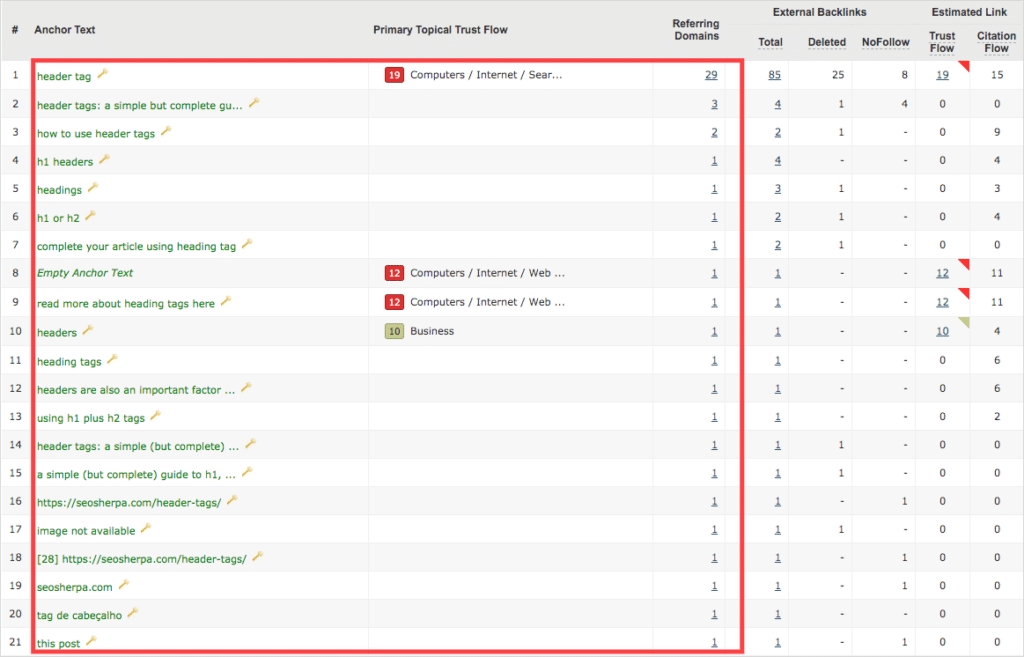
Once your anchor text data appears, you can either scan it manually, or export the data into an Excel spreadsheet.
The advantage of Excel is you can then categorize all of the anchors in your data according to their type (branded, naked, exact-match, etc.)
Of course, if you find you have too many of a certain anchor type, then you should put my eight strategies to work.
Over to you!
While anchor text’s role has diminished over the years, it should not be overlooked. In the eyes of Google, anchor text continues to play an integral role in the order and ranking of search results.
But, remember, anchor text is just one piece of the overall SEO puzzle.
Whether you’re developing your link-building strategy, writing SEO content, or auditing your on-page SEO, keep in mind these anchor text best practices.
To further help you in your anchor text optimization efforts, we’ve created an Anchor Text Cheat Sheet that includes all of these key strategies as well as two advanced tips and tactics to further your anchor text success.
You can download the FREE bonus below.

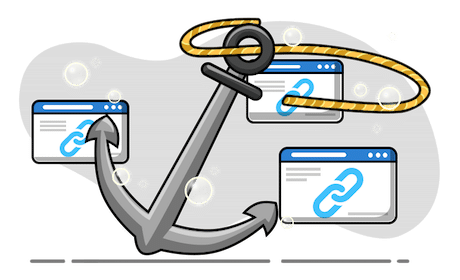

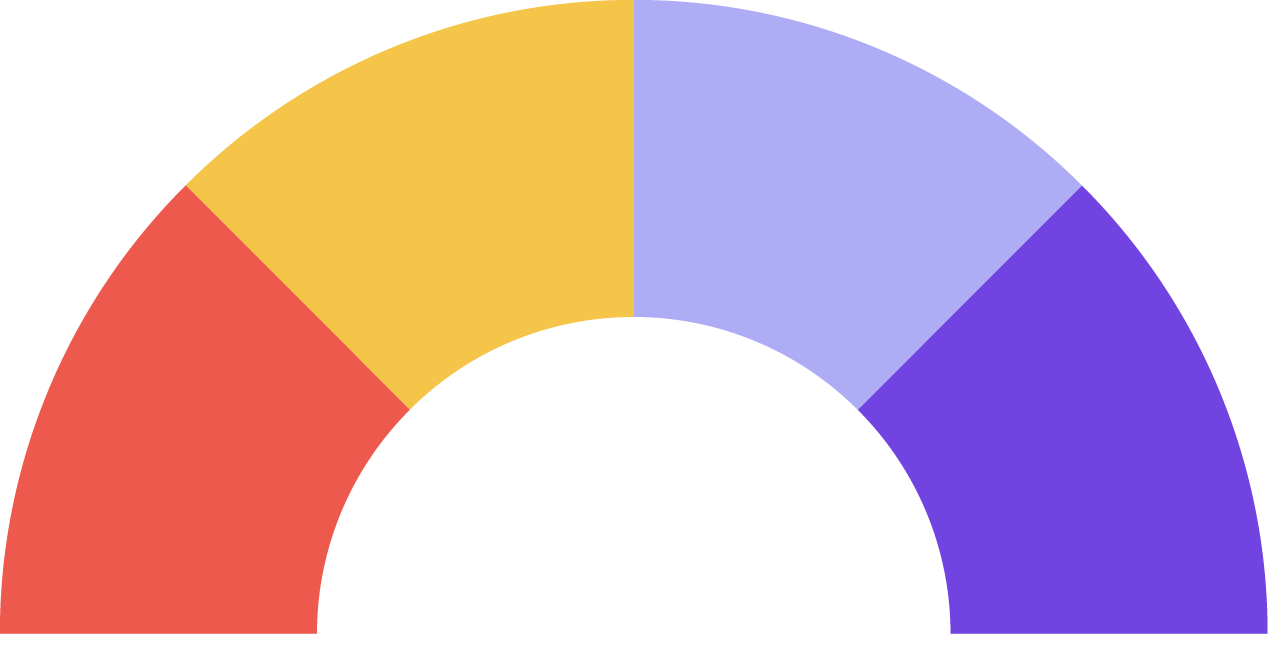


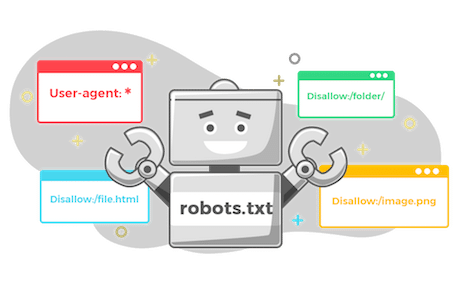




Leave a Reply